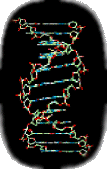 Reading the program notes can sometimes be very illuminating. Yesterday, for instance, at the concert of the Ensemble Wien-Berlin and Denes Varjon (piano), I learned something about molecular biology and its application to music. York Höller’s Klangzeichen for piano and wind quintet is a piece based on a Klanggestalt, a melodic structure from which all other materials in the composition are derived (this is essentially what Stockhausen calls Formel). “Höller,” as the program notes inform us, “compares his Klanggestalt to a ‘genetic code,’ upon which all of the features of the piece are based.”
Reading the program notes can sometimes be very illuminating. Yesterday, for instance, at the concert of the Ensemble Wien-Berlin and Denes Varjon (piano), I learned something about molecular biology and its application to music. York Höller’s Klangzeichen for piano and wind quintet is a piece based on a Klanggestalt, a melodic structure from which all other materials in the composition are derived (this is essentially what Stockhausen calls Formel). “Höller,” as the program notes inform us, “compares his Klanggestalt to a ‘genetic code,’ upon which all of the features of the piece are based.”
“A genetic code!”, I thought to myself, “wow, this is cool,” only to realize a couple of moments later, that the biological concept of gene expression proves difficult to apply to music. What we refer to as the “genetic code” is a mechanism that is used in cells to synthezise big molecules (proteins) which perform important functions in our bodies. The construction plans for these proteins are encoded in the DNA, another big molecule that resides in the core of each cell. The way this information is stored on the DNA is via a sequence of four letters (you can see them in the title of this blog entry: A, T, C, and G). The sequence of these letters is then transmitted to ribosomes (just think of them as molecule-machines) that reside outside of the core of the cell. The ribosomes in turn translate the short snippets of the DNA-sequence into real protein building blocks and knit them together. Voila, there you go, here’s your protein. (For a better explanation see http://en.wikipedia.org/wiki/Genetic_code )
The problem with the genetic-code-analogy is that if you read a sequence on the DNA molecule it will always produce the same protein, there is virtually no room for variation. Thus if there were only one way of transforming the musical materials of Höller’s Klanggestalt (what he calls the genetic code), this would result either in a very short or a very boring piece. Why not stick then, to the more traditional (but less technical) metaphor of “organicism”? It has been around for quite a while and has proven to be very successful in characterizing music. Or is the stale aftertaste of “organicism” what Höller is trying to avoid?




Discussion
No comments for “(5′ -> 3′) ATGGAATTCTCGCTC”